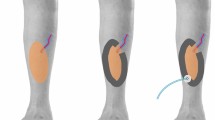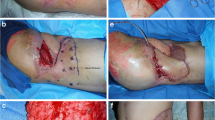Abstract
Since 1996, 41 patients have presented to our institution with deep but localized groin infection following bypass (30) or isolated femoral artery surgery (11). These patients were treated with antibiotics, debridement, and rotational muscle flap coverage either immediately or within a few days. Patients had one of three patterns: serous leak from a groin incision within a few days of operation (Acute, n = 10), early serous leak that later became grossly infected (Acute-observed, n = 8), or obvious purulent drainage following an initially normal, healed wound (Delayed, n = 23). Patients with early leak had nearly uniformly polymicrobial infections with a preponderance of gram-negative organisms, whereas most of those with late purulence had monobacterial infection with Staphylococcus aureus. At exploration, 26 of 41 suture lines were exposed. Rectus femoris flaps were used in 35 patients (85% of cases) for coverage, and graft preservation was attempted in all 8 vein grafts and 16 of 23 prosthetic grafts. Only one flap failed and there were no instances of anastomotic bleeding. There were no deaths directly attributable to reexploration and flap coverage, although 10 patients died during the index hospitalization. Durable coverage with no long-term evidence of infection was achieved in 24 patients with mean follow-up of 23 (range 10-66) months and another 12 had no evidence of local problems despite shorter follow-up; only 5 patients (12%) overall had evidence of persistent graft infection or unexplained bacteremia. In patients with attempted graft salvage, limb salvage was 97% at 6 months and 85% at 1 year. Although early mortality is high, deaths are not related to the flap procedure itself, local outcome is excellent, and graft and limb salvage are good; results are much worse if an initially draining wound is treated too late. Local rotational muscle flap closure is an excellent solution for acute infections involving the groin following vascular procedures.




Similar content being viewed by others
References
DE Szilagyi RF Smith JP Elliott MP Vrandecic (1972) ArticleTitleInfection in arterial reconstructions with synthetic grafts Ann. Surg. 176 321–333 Occurrence Handle1:STN:280:CSyD3cfotl0%3D Occurrence Handle4262892
M Wengrovitz RG Atnip RRM Gifford MM Neumyer DF Heitjan BL Thiele (1990) ArticleTitleWound complications of autogenous subcutaneous infrainguinal arterial bypass surgery: predisposing factors and management J. Vasc. Surg. 11 156–163 Occurrence Handle10.1067/mva.1990.16918 Occurrence Handle1:STN:280:By%2BC3M3mvVY%3D Occurrence Handle2296096
KC Kent S Bartek KM Kuntz E Anninos JJ Skillman (1996) ArticleTitleProspective study of wound complications in continuous infrainguinal incisions after lower limb arterial reconstruction: incidence, risk factors, and cost Surgery 119 378–383 Occurrence Handle1:STN:280:BymB387it1M%3D Occurrence Handle8644000
KA Illig JM Rhodes Y Sternbach RM Green (2003) ArticleTitleFinancial impact of endoscopic vein harvest for infrainguinal bypass J. Vasc. Surg. 37 323–330 Occurrence Handle10.1067/mva.2003.2 Occurrence Handle12563202
RS Shaw AE Baue (1962) ArticleTitleManagement of sepsis complicating arterial reconstructive surgery Surgery 53 75–86
JE Lorentzen OM Nielsen H Arendrup et al. (1985) ArticleTitleVascular graft infection: an analysis of sixty-two graft infections in 2411 consecutively implanted synthetic vascular grafts Surgery 98 81–86 Occurrence Handle1:STN:280:BiqB2crit1A%3D Occurrence Handle4012610
KJ Cherry CF Roland PC Pairolero et al. (1992) ArticleTitleInfected femorodistal bypass: is graft removal mandatory? J. Vasc. Surg. 15 295–305 Occurrence Handle10.1067/mva.1992.33846 Occurrence Handle1735890
KD Calligaro FJ Veith ML Schwartz et al. (1994) ArticleTitleSelective preservation of infected prosthetic arterial grafts: analysis of a 20-year experience with 120 extracavitary-infected grafts Ann. Surg. 220 461–471 Occurrence Handle1:STN:280:ByqD3s7jsVE%3D Occurrence Handle7944658
J Bostwick HL Hill F Nahai (1979) ArticleTitleRepairs in the lower abdomen, groin, or perineum with myocutaneous or omental flaps Plast. Reconst. Surg. 63 186–194 Occurrence Handle368827
RC Mixter WD Turnipseed DJ Smith SuffixJr CW Archer VK Rao DG Dibbell (1989) ArticleTitleRotational muscle flaps: a new technique for covering infected vascular grafts J. Vasc. Surg. 9 472–478 Occurrence Handle10.1067/mva.1989.vs0090472 Occurrence Handle1:STN:280:BiaC2Mjmt1M%3D Occurrence Handle2921796
W Peters R Cartotto S Morris M Jewitt (1991) ArticleTitleThe rectus femoris myocutaneous flap for closure of difficult wounds of the abdomen, groin, and trochanteric areas Ann. Plast. Surg. 26 572–576 Occurrence Handle1:STN:280:By6A2MzpvVw%3D Occurrence Handle1883166
BA Perler CA Vauder Kolk CR Dufresne GM Williams (1991) ArticleTitleCan infected prosthetic grafts be salvaged with rotational muscle flaps? Surgery 110 30–34 Occurrence Handle1:STN:280:By6A38jivFY%3D Occurrence Handle1866691
W Calderon N Chang SJ Mathes (1986) ArticleTitleComparison of the effect of bacterial inoculation in musculocutaneous and fasciocutaneous flaps Plast. Reconst. Surg. 77 785–794 Occurrence Handle1:STN:280:BimB3cnkslU%3D Occurrence Handle3704001
Alkon, JD, Smith, A, Losee, JE, Illig, KA, Green, RM, Serletti, JM “Management of complex groin wounds: preferred use of the rectus femoris flap” J. Plast. Reconstr. Surg. (in press)
RB Rutherford JD Baker C Ernst et al. (1997) ArticleTitleRecommended standards for reports dealing with lower extremity ischemia: revised version J. Vasc. Surg. 26 517–538 Occurrence Handle1:STN:280:ByiH2Mzpslw%3D Occurrence Handle9308598
KD Calligaro FJ Veith ML Schwartz RP Savarese DA DeLaurentis (1992) ArticleTitleAre gram-negative bacteria a contraindication to selective preservation of infected prosthetic arterial grafts? J. Vasc. Surg. 16 337–346 Occurrence Handle10.1067/mva.1992.38625 Occurrence Handle1:STN:280:By2A1MrntFA%3D Occurrence Handle1522635
KD Calligaro CJ Westcott RM Buckley RP Savarese DA DeLaurentis (1992) ArticleTitleInfrainguinal anastomotic arterial graft infections treated by selective graft preservation Ann. Surg. 216 74–79 Occurrence Handle1:STN:280:By2A3sjltVQ%3D Occurrence Handle1632705
GS Treiman S Copland AE Yellin PF Lawrence RM McNamara RL Treiman (2001) ArticleTitleWound infections involving infrainguinal autogenous vein grafts: a current evaluation of factors determining successful graft preservation J. Vasc. Surg. 33 948–954 Occurrence Handle10.1067/mva.2001.114209 Occurrence Handle1:STN:280:DC%2BD3M3mtlSisA%3D%3D Occurrence Handle11331833
B Maser N Vedder D Rodriguez K Johanson (1997) ArticleTitleSartorius myoplasty for infected vascular grafts in the groin: safe, durable, and effective Arch. Surg. 132 522–525 Occurrence Handle1:STN:280:ByiA3crht1U%3D Occurrence Handle9161396
WH Caulfield L Curtsinger G Powell WC Pederson (1994) ArticleTitleDonor leg morbidity after pedicled rectus femoris muscle flap transfer for abdominal wall and pelvic reconstruction Ann. Plast. Surg. 32 377–382 Occurrence Handle1:STN:280:ByuB2s%2FmvFQ%3D Occurrence Handle8210156
Author information
Authors and Affiliations
Corresponding author
About this article
Cite this article
Illig, K.A., Alkon, J.E., Smith, A. et al. Rotational Muscle Flap Closure for Acute Groin Wound Infections Following Vascular Surgery. Ann Vasc Surg 18, 661–668 (2004). https://doi.org/10.1007/s10016-004-0105-7
Published:
Issue Date:
DOI: https://doi.org/10.1007/s10016-004-0105-7




